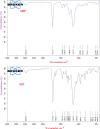Determination of profenofos in seawater and foodstuff samples after its molecularly imprinted polymer pipette-tip micro solid phase extraction optimized by response surface methodology
- PMID: 35292077
- PMCID: PMC8922791
- DOI: 10.1186/s13065-022-00807-z
Determination of profenofos in seawater and foodstuff samples after its molecularly imprinted polymer pipette-tip micro solid phase extraction optimized by response surface methodology
Abstract
Background: In this research, a molecularly imprinted polymer (MIP) was synthesized and employed as a sorbent for pipette-tip micro solid phase extraction of profenofos insecticide in seawater, rice, and fish samples. The instrument employed for quantitation was spectrophotometry.
Results: Various factors affecting the microextraction protocol, including type and volume of the elution solvent, weight of MIP, pH and volume of sample solution, and number of cycles of loading and desorption were considered and optimized using one-factor-at-a-time, central composite design and Box-Behnken design. Factors optimized at: pH 4.0, amount of sorbent 2.5 mg, volume of methanol:acetic (9:1) acid as eluent 250 µL, both the number of extraction and elution cycles 5, and volume of sample 8.0 mL. At optimized conditions, an enrichment factor of 31 was achieved and the linearity range of the method was between 1.0 and 1000.0 µg/L. A good detection limit of 0.33 µg/L with a reproducibility better than 5.6% (as RSD) was observed.
Conclusion: The technique showed good analytical features for determination of profenofos in seawater, rice, and fish samples. Simplicity of operation of spectrophotometry and lack of using expensive HPLC grade solvents are other points of strengths of this method. The total analysis time was about 10 min, which is far less than techniques such as HPLC. Comparison between optimization with central composite design and Box-Behnken design showed better performance of the former.
Keywords: Food samples; Molecularly imprinted polymer; Pipette tip micro-solid phase extraction; Profenofos; Response surface methodology; Seawater analysis.
© 2022. The Author(s).
Conflict of interest statement
The authors declare that there is no conflict of interests regarding the publication of this paper.
Figures






Similar articles
-
Separation and determination of ciprofloxacin in seawater, human blood plasma and tablet samples using molecularly imprinted polymer pipette-tip solid phase extraction and its optimization by response surface methodology.J Sep Sci. 2020 Jan;43(2):505-513. doi: 10.1002/jssc.201900923. Epub 2019 Dec 5. J Sep Sci. 2020. PMID: 31657096
-
Application of Box-Behnken design in response surface methodology for the molecularly imprinted polymer pipette-tip solid phase extraction of methyl red from seawater samples and its determination by spectrophotometery.Mar Pollut Bull. 2018 Dec;137:306-314. doi: 10.1016/j.marpolbul.2018.10.037. Epub 2018 Oct 20. Mar Pollut Bull. 2018. PMID: 30503439
-
Box-Behnken design optimization of pipette tip solid phase extraction for methyl orange and acid red determination by spectrophotometry in seawater samples using graphite based magnetic NiFe2O4 decorated exfoliated as sorbent.Spectrochim Acta A Mol Biomol Spectrosc. 2019 Apr 15;213:218-227. doi: 10.1016/j.saa.2019.01.049. Epub 2019 Jan 21. Spectrochim Acta A Mol Biomol Spectrosc. 2019. PMID: 30690305
-
Application of response surface methodology for optimization of metal-organic framework based pipette-tip solid phase extraction of organic dyes from seawater and their determination with HPLC.BMC Chem. 2019 Apr 23;13(1):59. doi: 10.1186/s13065-019-0572-0. eCollection 2019 Dec. BMC Chem. 2019. PMID: 31384807 Free PMC article.
-
Synthesis of chitosan based molecularly imprinted polymer for pipette-tip solid phase extraction of Rhodamine B from chili powder samples.Int J Biol Macromol. 2019 Oct 15;139:40-48. doi: 10.1016/j.ijbiomac.2019.07.196. Epub 2019 Jul 30. Int J Biol Macromol. 2019. PMID: 31369780
Cited by
-
Deep Eutectic Solvent Stir Bar Sorptive Extraction: A Rapid Microextraction Technique for the Determination of Vitamin D3 by Spectrophotometry.ACS Omega. 2023 Jun 23;8(26):23643-23650. doi: 10.1021/acsomega.3c01670. eCollection 2023 Jul 4. ACS Omega. 2023. PMID: 37426244 Free PMC article.
-
A chemometric approach based on response surface methodology for optimization of antibiotic and organic dyes removal from water samples.BMC Chem. 2024 Jan 3;18(1):5. doi: 10.1186/s13065-023-01107-w. BMC Chem. 2024. PMID: 38172983 Free PMC article.
-
Optimization of variables for cadmium and copper removal using magnetic nanocomposite.BMC Chem. 2025 May 18;19(1):132. doi: 10.1186/s13065-025-01502-5. BMC Chem. 2025. PMID: 40383819 Free PMC article.
-
Determination of mitoxantrone in environmental waters: a spectrophotometric method with preconcentration by salt saturated pipette-tip micro solid phase extraction using molecularly imprinted polymer.Turk J Chem. 2025 Apr 4;49(3):267-278. doi: 10.55730/1300-0527.3728. eCollection 2025. Turk J Chem. 2025. PMID: 40656879 Free PMC article.
-
Porous Polymer Sorbents in Micro Solid Phase Extraction: Applications, Advantages, and Challenges.Top Curr Chem (Cham). 2024 Nov 18;382(4):37. doi: 10.1007/s41061-024-00481-w. Top Curr Chem (Cham). 2024. PMID: 39557712 Review.
References
-
- Edwards C. Environmental pollution by pesticides. Environ Pollut Pestic. 2012;3:1–9.
-
- Bodur S, Erarpat S, Bakırdere S. Fe3O4/reduced graphene oxide nanocomposites based dispersive solid phase microextraction for trace determination of profenofos in white rice flour samples. J Food Compost Anal. 2020;91:103516. doi: 10.1016/j.jfca.2020.103516. - DOI
LinkOut - more resources
Full Text Sources
